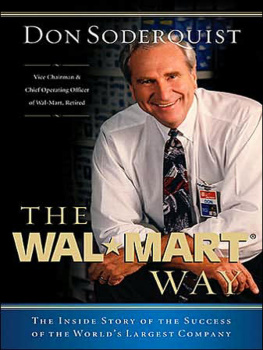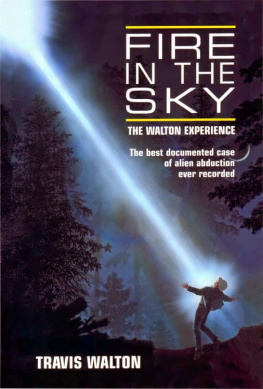Table of Contents
To Ann, Kevin, and Emily,
great journalists, treasured friends
This image is from a prized possession of the authors: a T-shirt from Wal-Marts 1986 shareholders meeting.
Introduction
Meeting Mr. Sam
THE DAY WAS young and the seats werent yet full, but the richest man in America was already bouncing around the auditorium like a kid who had eaten too much candy. Samuel Moore WaltonMr. Sam to manyhad a microphone in his hand and was working the crowd, hustling from person to person to encourage longtime employees to share their stories about his baby, the Wal-Mart Stores chain.
As a reporter for the Wall Street Journal, I had been warned to arrive early on this June morning in 1986 for the 10 a.m. annual meeting of Wal-Marts stockholders. But even 8 oclock was barely early enough for a gathering that had started near dawn. The WalMart auditorium in Bentonville, Arkansas, was filling quickly, and some people would have to watch on TV from the company cafeteria.
Mr. Sam was now sixty-eight years old, white-haired, beaknosed, and slightly stooped, but to hundreds of Wal-Mart employees who had come to Arkansas on buses from as far as Florida, he was the closest they would ever get to American royalty. In 1962, he had opened his first Wal-Mart Discount City in nearby Rogers, Arkansas. Expanding slowly at first, and then faster and faster, the discount chain was now the nations fifth largest retailerand it was just getting going. Owning a big piece of it had created a Walton family fortune worth billions of dollars.
But Mr. Sam wasnt about wealth. Making gobs of money was never his goal. His passion, his love, and his laser-beam focus were, instead, always on his business, on rolling out new Wal-Marts and Sams Clubs and selling mountains of underwear, socks, toys, toothpaste, and thousands of other items at lower prices than just about anyone else.
Company annual meetings are usually painfully dull, numbersriddled affairs, but this Wal-Mart meeting was a giant pep rally, led by cheerleader Sam. In the early days, when no one in his right mind wanted to travel to Nowhere, Arkansas, Sam had a hard time getting Wall Streets attention. Then he began putting on a high-energy show for employees and other shareholders, and New York investing big shots started to attend.
Now, between the patriotic songs and slide shows, the governor of Arkansas, Bill Clinton, spoke, and two professional basketball players who had once played for the University of Arkansas came onstage to thunderous shouts and applause. Country singer Reba McEntire performed. And one executive, after promising a pigskin to another, actually presented him with a small, squealing pig.
Speakers rally the crowd at Wal-Marts 1985 stockholder gathering.
Then Sam, wearing a Wal-Mart ball cap, enthusiastically pumped up the crowd.
Weve got the best group of people ever assembled in retailing! he declared. Were off to the best start of any Wal-Mart year in history!
He challenged the employees in attendance to meet new and bigger goals for the next year. The crowd loudly and enthusiastically responded with the companys slogan, Yes, we can!
The meeting ended with Mr. Sam leading the Wal-Mart cheer: Give me a W! Give me an A! Give me an L! Give me a squigglywhich, properly done, was accompanied by a wiggle of the hipsand so on, until the fired up audience was roaring and ready to ring up more sales.
Afterward, Sam and his wife Helen invited the out-of-town employees to their house for box lunches, where he shook hands, posed for pictures, and visited one by one with clerks and managers from hundreds of stores.
This aw-shucks, one-of-the-guys billionaire was the public Sam Walton. The private one was more reserved, more serious, a shrewdand sometimes ruthlesscompetitor who wanted nothing more than to whup the competition down the street, the stores across town, and those across the country. Money might not be that meaningful to him, but winning certainly was.
By his own admission, he relentlessly copied every good idea he could find. He would lease a building so that someone else couldnt. He raided rivals top talent and hounded suppliers to lower their prices. He was so focused on cutting prices for customers and improving sales that he sometimes ignored other business considerations, like paying clerks well or promoting women and minorities. He shrugged off criticism that his big discount stores were destroying downtowns and demolishing local retailers in small communities. Having started as a small-town retailer himself, he saw his job as taking care of customers; other retailers could fend for themselves.
Today, about twenty-five years after that noisy, energetic meeting, Wal-Mart Stores, Inc. operates in more than fifteen countries and employs more than two million people, including well over one million in the United States. Just about two of every three Americans will shop at one of its stores, which now sport signs with a new spelling, Walmart, dropping the long-time hyphen to match the companys website, www.walmart.com.
Its annual sales of more than $400 billion make it the largest company in America and the largest retailer in the world, ringing up more than $1.1 billion every day, almost $800,000 every single minute.
Mr. Sam saw only glimmers of this retailing mammoth. He passed away in 1992, when Wal-Mart was one-tenth as big as it is today. Since then, its remarkable size and clout have made it increasingly controversial. Many people believe the company is too cheap in its business practices, too big, and too focused on low prices at the expense of good corporate citizenship.
But back in 1986, Sam Waltons chain was just beginning to grow out of the South and Southwest and reach toward Michigan and California. He was a regional player with an eye for great ideas, iron determination, and outrageous dreams. What he wanted most of all was to build the worlds best retailer and to bring low everyday prices to every American.
By relentlessly driving for his goal, he got all thatand quite a bit more than he bargained for.
Often a leader at school and in college, Sam (fourth from left in top photo) was elected president of the University of Missouri class of 1940.
Chapter 1:
Win! Win! Win!
FROM THE TIME that he was very young, Sam Walton loved to competeand to win.
He competedand wonin football and basketball. He ran forand was elected tooffices in all kinds of school activities. He even managed to make the Boy Scouts competitive. When he was in grade school in Marshall, Missouri, he bet his pals that he that he would be the first one to make Eagle Scout. Before he reached his goal, though, his family moved about a hundred miles northeast, to tiny Shelbina, Missouri, a town of about 1,500 people.















